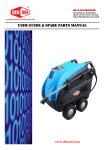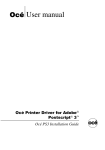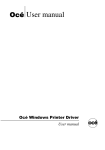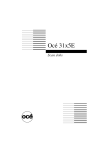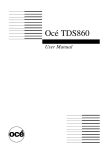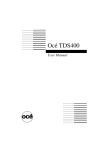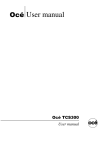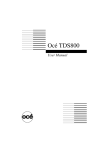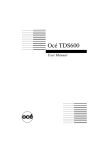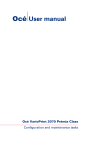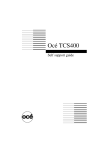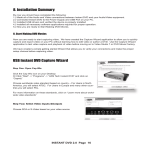Download Océ TCS500 - Océ | Printing for Professionals
Transcript
Océ Self support guide Océ TCS500 Océ TCS500 Self support guide Océ-Technologies B.V. © 2005 Océ. All rights reserved. No part of this work may be reproduced, copied, adapted, or transmitted in any form or by any means without written permission from Océ. Océ makes no representation or warranties with respect to the contents hereof and specifically disclaims any implied warranties of merchantability or fitness for any particular purpose. Further, Océ reserves the right to revise this publication and to make changes from time to time in the content hereof without obligation to notify any person of such revision or changes. Edition: 2005-08 Safety information Safety information This manual contains the following safety information. ■ Instructions for safe use. You are advised to read this information before you start to actually use the system. Technical safety information such as safety data sheets can also be found in this chapter. ■ Where applicable, attentions are used throughout this guide to point out safety precautions to be taken. 3 Contents Contents Chapter 1 Self support tips (GB).........................................................................................5 What to do when a problem occurs.........................................................6 Correct a problem.................................................................................6 What to do when you are not satisfied with the output quality.............7 Achieve optimal output quality...........................................................7 Define the correct job settings for optimal output quality................9 Use the wizards to achieve optimal output quality.........................13 What to do when the system indicates a defective printhead.............15 Use the Replace printhead wizard to change a defective printhead.....................................................................................................15 What to do when you have problems with the sending of print jobs..17 Important points for the sending of print jobs.................................17 Chapter 2 Safety information (GB)...................................................................................19 Instructions for safe use..........................................................................20 Safety data sheets....................................................................................22 EPA Energy Star®....................................................................................24 4 Chapter 1 Self support tips (GB) Correct a problem What to do when a problem occurs Correct a problem When a problem occurs, there are two options. ■ ■ Use the wizards. Use the on-line / off-line key (key 4 on the folded cover) on the printer operator panel to go off-line to the wizard selection screen. Use the user manual on the documentation CD-ROM for detailed descriptions about how to correct problems. Use the wizards to correct problems Use the wizards to do one of the following. ■ Use the 'Feed & cut' wizard to cut the output or to clean cut a roll of media. Chapter 7 of the user manual includes complete information about how to use this wizard. ■ Use the 'Change media type' wizard to change the media type defined on the system. ‘Define the correct job settings for optimal output quality’ on page 9 ■ Use the 'Optimize print quality' wizard as a final option to correct the problems with the print quality. ‘’ on page 13 ■ Use the 'Replace printhead' wizard to replace a defective printhead. ‘’ on page 15 ■ Use the 'Replace cassette' wizard to replace the maintenance cassette. Chapter 10 of the user manual includes complete information about this wizard. ■ Use the 'Configure system' wizard to check the network settings. When you do not have a keyboard, mouse and monitor with your controller, you can also use the 'Configure system' wizard to clear the set memory. Chapter 4 of the user manual includes complete information about this wizard. Use the user manual on the documentation CD-ROM to correct problems When the information in this guide does not completely support you while you use the Océ TCS500, refer to the user manual on the user documentation CD-ROM for more information. 6 Chapter 1 - Self support tips (GB) Achieve optimal output quality What to do when you are not satisfied with the output quality Achieve optimal output quality Introduction The Océ TCS500 offers 2 methods to check the print quality. ■ Make a quality check print ■ Make a demo print. On the system information card on the on-line screen of the printer, use the lower softkey for 'Demo print' (key 6 on the folded cover) to enter the menu with the quality check print and the demo print. Chapter 8 of the user manual includes a section about how to check the print quality. When you are not satisfied with the output quality, use the following procedure 1. Make sure that you load and define the correct media type on the printer. Load a media roll and use the 'Change media type' wizard to change the media type defined on the system. 2. Make sure you define the correct media type for your job. The following problems are never connected to media. Ignore the above steps for these problems and directly continue with step 3. ‘Important points for the sending of print jobs’ on page 17 The length and width measurements are different from the original The colored lines are not well aligned Missing sections in lines or stepped lines Missing parts of characters Drop-out caused by nozzle problems. Make sure you defined the correct print mode for your job. ‘Use the wizards to achieve optimal output quality’ on page 13. 3. When you have defined the correct media and the correct print mode, and you are still not satisfied with the output quality, use the wizards to achieve optimal output quality. ‘Use the wizards to achieve optimal output quality’ on page 13. Note: Chapter 8 of the user manual includes a table with recommended media types and print modes for the different types of jobs. Chapter 1 - Self support tips (GB) 7 Achieve optimal output quality Note: Chapter 8 of the user manual includes a table with a complete overview of the settings and the methods to correct specific problems with the output quality. 8 Chapter 1 - Self support tips (GB) Define the correct job settings for optimal output quality Define the correct job settings for optimal output quality Introduction To get optimal output quality, define the correct print modes. Use the following order to define the print modes. 1. Define the correct media settings. The website http://supplies.oce.com includes information about the correct media settings for your jobs. 2. Define the correct 'Color mode'. 3. Define the correct 'Print quality'. Chapter 8 of the user manual includes information about the recommended job settings for your jobs. Definition Define the correct color mode Define the correct color mode# When Then The original is in color and the printed output requirement is color set the 'Color mode' to 'Color' The original is in color and the printed output requirement is grayscale set the 'Color mode' to 'Grayscale' The original is grayscale set the 'Color mode' to 'Grayscale' Define the correct print quality Define the correct print quality mode# When Then Example Speed is the most important requirement. Set the 'Print quality' to 'Check' Use this mode, for example, to check if all the information is visible on the printed output. The speed requirement and the print quality requirement are balanced. Set the 'Print quality' to 'Release'. Use this mode, for example, to approve bid-sets or for internal releases of drawings Chapter 1 - Self support tips (GB) 9 Define the correct job settings for optimal output quality When Then Example The quality is the most important requirement. Set the 'Print quality' to 'Presentation' Use this mode, for example, to present drawings to the customers. How to correct typical inkjet artifacts Use the print modes to correct typical inkjet artifacts# When Then Ink saturation causes the media to cockle ■ ■ ■ The print contains regular horizontal light or dark bands ■ ■ ■ The filled areas contain white stripes ■ ■ The colored lines are not well aligned or blurred ■ ■ ■ 10 Chapter 1 - Self support tips (GB) Use coated media. Use the default drying time. Remove the printer from areas of high humidity. The media type defined on the printer must be the same as media roll available on the printer. When the media type defined on the printer is not the same as the media available on the printer, use the 'Change media type' wizard to change the media type Use the 'Presentation' quality mode Use the 'Optimize print quality' wizard to correct the problem. Use the 'Presentation' quality mode Use the 'Optimize print quality' wizard to correct the problem. Use the 'Presentation' quality mode Use the 'Optimize print quality' wizard to correct the problem. When failing printheads cause this problem, use the 'Replace printhead' wizard to replace the failing printheads. Define the correct job settings for optimal output quality When Then The color of one area or line runs into the color of another area or line ■ ■ ■ ■ Parts of lines are missing or lines are stepped ■ ■ ■ Parts of characters are missing ■ ■ On high gloss photo paper the individual ink drops merge on the media The media type defined on the printer must be the same as the media available on the printer. When the media type defined on the printer is not the same as the media available on the printer, use the 'Change media type' wizard to change the media type Use coated media Use the default drying time Remove the printer from areas of high humidity. Use the 'Presentation' quality mode Use the 'Optimize print quality' wizard to correct the problem. When failing printheads cause this problem, use the 'Replace printhead' wizard to replace the failing printheads. Use the 'Presentation' quality mode Use the 'Optimize print quality' wizard to correct the problem. Coalescence occurs in the 'Check' mode when you print on high gloss photo paper. Use the 'Release' or 'Presentation' quality mode Chapter 1 - Self support tips (GB) 11 Define the correct job settings for optimal output quality When Then The length and width measurements are different from the original ■ ■ ■ ■ ■ 12 Chapter 1 - Self support tips (GB) Make sure you defined the correct scale settings Use the 'Presentation' quality mode Use the 'Optimize print quality' wizard to correct the problem. In case of a media length deviation, adjust the setting Key Operator Printer - Media settings - Cut length correction in the Océ Settings Editor. In case of a image length deviation, set the Key Operator - Printer Vertical print optimization to 'Size accuracy' and adjust Key Operator Printer - Image length correction in the Océ Settings Editor. Use the wizards to achieve optimal output quality Use the wizards to achieve optimal output quality When to do Before you start the 'Optimize print quality' wizard, first check the following. ■ Did you define the correct media type for your job? ‘Define the correct job settings for optimal output quality’ on page 9 ■ Did you define the correct print mode settings for your job? ‘’ on page 9 After you checked that you used the correct media and the correct print modes, use the 'Optimize print quality' wizard to solve the following problems on your printed output. ■ Regular horizontal light or dark bands on the output ■ White stripes in filled areas ■ The length and width measurements are different from the original ■ The colored lines are not well aligned or blurred ■ Missing sections in lines or stepped lines ■ Parts of characters are missing ■ Drop-out caused by nozzle problems. Chapter 8 of the user manual includes complete information about how to optimize the print quality. Before you begin During the 'Optimize print quality' wizard, the system does a calibration. The calibration is only possible on one of the following media types indicated below. Before you start the wizard, first load and define one of these media types on the printer. ■ Draft paper ■ Standard paper ■ Premium coated paper ■ Bond ■ Coated bond ■ Matt photo paper ■ High gloss photo paper ■ Deluxe bond ■ Recycled plain paper ■ Plain paper coated How to start the Optimize print quality wizard 1. Press the on-line / off-line key (key 4 on the folded cover) to set the printer off-line. Chapter 1 - Self support tips (GB) 13 Use the wizards to achieve optimal output quality 2. Press the lower softkey for 'Optimize print quality' (key 6 on the folded cover) to enter the wizard. 3. Follow the steps of the wizard. 4. The screen displays feedback about the calibration process. The system does a nozzle failure recovery and alignment. You can stop the process at any time. Press the key for 'Cancel' to stop the calibration process. In case more than 75 nozzles fail, a 'Printheads failing' message appears. Then you must replace the printhead, using the 'Replace printhead' wizard . 14 Chapter 1 - Self support tips (GB) Use the Replace printhead wizard to change a defective printhead What to do when the system indicates a defective printhead Use the Replace printhead wizard to change a defective printhead When to do The system indicates the defective printhead. Only replace the printhead indicated by the system. Chapter 10 of the user manual includes complete information about how to replace a defective printhead. Before you begin During the 'Replace printhead' wizard, the system does a calibration. The calibration is only possible on of the following media types. ■ Draft paper ■ Standard paper ■ Premium coated paper ■ Bond ■ Coated bond ■ Matt photo paper ■ High gloss photo paper ■ Deluxe bond ■ Recycled plain paper ■ Plain paper coated How to start the Replace printhead wizard Attention: Only open the top cover when the wizard prompts you. 1. Press the on-line / off-line key (key 4 on the folded cover) to set the printer off-line. 2. Press the lower softkey for 'Replace printhead' (key 6 on the folded cover) to enter the wizard. Chapter 1 - Self support tips (GB) 15 Use the Replace printhead wizard to change a defective printhead 3. Follow the steps of the wizard. At the end of the wizard, the printer calibrates. 4. When the calibration is completed, the screen displays the calibration status. 16 Chapter 1 - Self support tips (GB) Important points for the sending of print jobs What to do when you have problems with the sending of print jobs Important points for the sending of print jobs Definition Before you send print jobs to the Océ TCS500, remember the following. ■ ■ ■ ■ The values defined in the Océ Settings Editor are default values for the system. You can define a number of job settings in the printer drivers or the job submission tools. The settings defined in the printer drivers or the job submission tools always overrule the settings defined in the Océ Settings Editor. Chapter 5 of the user manual and the on-line help in the Océ Settings Editor include complete information about the Océ Settings Editor Make sure that you define the correct print mode for your job. Make sure that you define the correct job settings. For example, orientation, rotate, shift, and automatic roll switching. The section about the correct media types for your jobs describes the job settings you can use with the different media types and sizes. Make sure that you define the correct media type for your job. Note: When the requested media type is not available on the printer, the printer will give a media request. The job is then placed on hold in the print queue. After the correct media is loaded on the printer and after you 'Resume' the job, the job will be printed. When the job is placed on hold in the print queue, you can also select another media roll for your job, with the option 'Settings''Job properties' in the Océ Queue Manager. A job submission tool like Océ Print Exec® Workgroup, provides you with information about the media defined on the system. The printer drivers do not give this type of information. When you use the printer drivers to send your jobs, use Océ Remote Logic to view information about the media defined on the printer in the Océ System Control Panel. Chapter 7 of the user manual includes more information about how to send print jobs to the Océ TCS500. Chapter 7 includes more information about how to define the correct media settings for your jobs. Chapter 1 - Self support tips (GB) 17 Important points for the sending of print jobs 18 Chapter 1 - Self support tips (GB) Chapter 2 Safety information (GB) Instructions for safe use Instructions for safe use Introduction Océ designed products are tested in accordance with the strictest international safety standards. It is important that you observe the safety rules included in this appendix to help assure safe working with the Océ TCS500. Maintenance ■ ■ ■ ■ ■ ■ ■ Do not remove any screws from fixed panels. Do not do any maintenance activities other than the maintenance activities for the parts and the maintenance materials described in this manual. Do not place any liquids on the machine. Use maintenance materials and other materials for their original purpose only. Keep maintenance materials away from children. Do not mix cleaning fluids or other substances. To avoid the risk of introducing hazards, all modifications to Océ equipment are strictly reserved to properly qualified and trained service technicians. Connection Attention: Do not move the machine yourself, but contact your Customer Service. It is recommended to connect only those products which meet the (inter)national product safety and radio frequency interference standards, and to use an attachment cable as specified by Océ. ■ ■ ■ ■ ■ ■ ■ 20 If for some reason you have to move the machine yourself, please make sure that the mains power point has the right fuse capacity. See the Océ TCS500 safety data sheet in this appendix for information about maximum current. Do not open more than one drawer at the same time. Do not bridge any mechanical or electrical circuit breakers. Do not use an extension lead to connect the machine. This machine is not designed for connection to an IT power system. An IT power system is a voltage network in which the neutral wire is not connected to ground. When the machine is connected through a wall socket, place the machine near a wall socket that is easily accessible. When the machine is connected through a fixed connection to the electricity grid, the disconnect device in the fixed connection must be easily accessible. Chapter 2 - Safety information (GB) Instructions for safe use Surroundings ■ ■ ■ ■ Make sure that the machine is placed on a level, horizontal surface of sufficient strength. See the Océ TCS500 safety data sheet in this appendix for information about the weight of the equipment. Make sure there is sufficient space around the machine. This facilitates reloading materials as well as maintenance. Do not place the machine in rooms which are subject to excessive vibration. Do not place the machine in rooms which are too small or insufficiently ventilated. See the Océ TCS500 safety data sheet in this appendix for information about space and ventilation requirements. General ■ ■ Always use materials recommended by Océ and developed for the Océ TCS500. Materials not approved by Océ can cause faults in your machine. Do not use the machine when it is emitting unusual sounds. Remove the plug from the power socket or turn off the fixed connection to the electricity grid and contact Customer Service. Note: This is a class B product. Chapter 2 - Safety information (GB) 21 Safety data sheets Safety data sheets Introduction The disclaimer below applies to all safety data sheets in this manual. Contact your local Océ organization for questions about Océ products regarding health, safety and environment. You can find the address of your local Océ organization in the appendix of this manual. Disclaimer The safety data sheets in this manual have been compiled to the best of our knowledge. They are intended as a compact guide to the safe handling of this product. We reserve the right to revise safety data sheets, as new information becomes available. It is the user's responsibility to determine the suitability of this information for the adoption of safety precautions as may be necessary. It is the user's responsibility to contact Océ to make sure that the safety data sheets are the latest ones issued. If and in so far as limitation of liability is permitted under the applicable laws, we do not accept liability for any inaccuracy that may occur in this information. 22 Chapter 2 - Safety information (GB) Safety data sheets Product safety data sheet Océ TCS500 printer PRODUCT SAFETY DATA SHEET Number Date Model Océ TCS500 Description Max. process speed console model, wide format inkjet printer 1,0 A0/min Dimensions Width Depth Height Weight Voltage Frequency Current-rated Building fuse Power consumption, stand-by Power consumption, operation EPA ENERGY STAR ® * Power consumption sleep mode Mains connection Safety class Protection class Sound pressure level (at operator position) Sound power level Radio interference Radiation Heat emission Dust concentration Ozone emission 1958 1034 1465 180 mm mm mm kg 230 50-60 2,0 16 160 205 V Hz A A W W 100 50-60 9,0 16 V Hz A A 120 60 9,0 16 E-795-a-US August 2005 V Hz A A 59 W Cable with plug I (IEC 536) Protective earth connection IP 20 (IEC 529) Standby LpA = 33 dB(A) In operation LpA = 47 dB(A) LWA = 52 dB(A) LWA = 66 dB(A) Complies with Directive 89/336/EEC and FCC rules and regulations, part 15 Class A. not applicable Standby 160 W; at continuous operation 205 W < 0,01 mg/ m3 not applicable Room volume Room ventilation Recommendation: min.15 m3 Recommendation: min. 7,5 m3/h (natural ventilation) Consumables Océ TCS500 Inks (Océ Material Safety Data Sheet E-260) Additional safety information None Listed according to standard UL 60950-1 and CAN/CSA-C22.2 No. 60950-1-03 EPA ENERGY STAR ® LISTED 927F INFORMATION TECHNOLOGY EQUIPMENT E 69871 Copyright © 2005 Océ-Technologies B.V., Venlo, NL The content of this safety data sheet is subject to the disclaimer of liability on page ‘Disclaimer’ on page 22 of this manual. Chapter 2 - Safety information (GB) 23 EPA Energy Star® EPA Energy Star® Introduction Océ-Technologies B.V. has joined the Energy Star® Program of the United States Environmental Protection Agency (EPA). The purpose of the Energy Star® Program is to promote the manufacturing and marketing of energy-efficient equipment, thereby potentially reducing combustion-related pollution. Using the energy management features outlined below prevents unnecessary power consumption, which helps to prevent air pollution from electricity generating plants and saves money on your utility bills. As an Energy Star® Partner, Océ-Technologies B.V. has determined that this printer model meets the Energy Star® guidelines for energy efficiency. See the Product Safety Data Sheet in this appendix for power use data. Attention: If this printer is upgraded to a multifunctional device by adding a wide format color scanner, the system does not comply with the ENERGY STAR sleep mode specification for a wide format multifunction device. The Energy Star® logo which appears in the printer operator panel only refers to the printer. Features The EPA Energy Star® Criteria for printers involves the following feature. ■ Sleep mode The power use of some functions is automatically decreased to save energy. The printer enters the sleep mode 30 minutes after the last print job is completed. The key operator can adjust this default time within a range between 30 and 240 minutes. It is suggested to determine the appropriate default time for your work pattern by changing the setting in steps of 30 minutes and testing each setting for at least a week. Only if this limit of 240 minutes still causes sizable inconvenience, due to your usage pattern, the key operator can disable the sleep mode. 24 Chapter 2 - Safety information (GB) EPA Energy Star® Energy Star® is a U.S. registered mark. Chapter 2 - Safety information (GB) 25 Index Index Job submission Job submission ...............................................17 M Media settings Media settings ...................................................9 O Off-line mode Off-line mode ...................................................6 Output quality Output quality .............................................7, 9 P Print modes Print modes ......................................................9 S System screen System screen ....................................................6 U User manual User manual .....................................................6 W Wizards Wizards ............................................................6 26


























